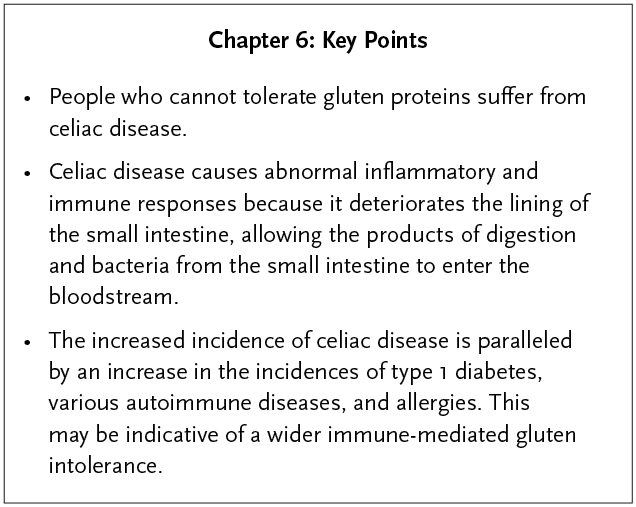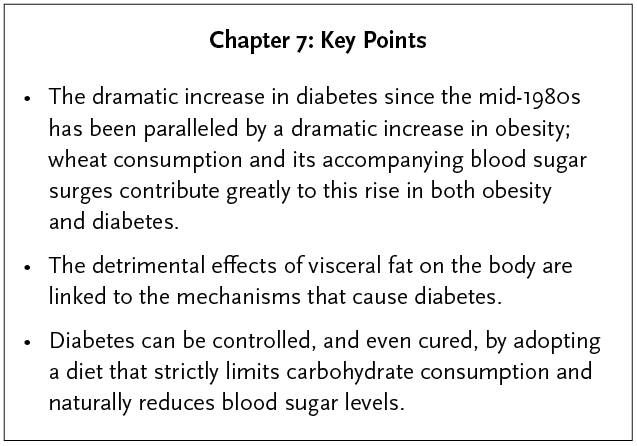Summary: Wheat Belly ...in 30 Minutes (4 page)
Read Summary: Wheat Belly ...in 30 Minutes Online
Authors: 30 Minute Health Summaries

HELLO, INTESTINE. IT'S ME, WHEAT. WHEAT AND CELIAC DISEASE
Overview
The most dramatic manifestation of wheat intolerance is celiac disease, and its diagnosis has increased fourfold in the past fifty years. According to Davis, this surge in celiac incidence is a result of the modern genetic modifications made to wheat and, in particular, gluten proteins. Celiac disease breaks down the lining of the small intestine, allowing antibodies and bacteria into the bloodstream and causing abnormal inflammatory and immune responses. Its mechanism may be responsible for a wide range of diseases that all relate back to gluten intolerance.

“[T]he increase in celiac disease has been paralleled by an increase in type 1 diabetes, autoimmune diseases such as multiple sclerosis and Crohn's disease, and allergies.”
â Dr. William Davis,
Wheat Belly

Chapter Summary
Research suggests that the incidence of celiac disease has increased fourfold over the past fifty years. The rise in the number of effected people can be partially attributed to better diagnostics, but researchers agree that the true incidence is also on the rise. They do not agree about why, though. This increase has been paralleled by an increase in type
1
diabetes and in autoimmune diseases such as multiple sclerosis, Crohn's disease, and allergies.
Wheat may be part of the explanation. Researchers in the Netherlands compared modern strains of wheat with strains that were widely available until a century ago, and found that celiac-triggering gluten proteins were expressed in higher levels in modern wheat, while non-celiac-triggering proteins were expressed less.
When people who suffer from celiac disease eat anything that contains gluten, the gliadin protein of gluten breaks down the lining of their small intestines, making it permeable. As the lining gets damaged, it allows the various products of digestion, as well as helpful bacteria from the small intestine, to enter the bloodstream. When substances that are not supposed to escape from the intestines do, one effect is autoimmunity â the immune system believes the body is under attack and attacks itself.
Although diarrhea and abdominal cramping are the most common signs of celiac disease, in many cases the signs are atypical, such as anemia, skin rash, allergies, or migraine headaches, or there are no immediate signs of disease. The problem then goes undiagnosed.
While celiac is a damaging disease on its own, it is made even more dangerous by the accompanying conditions prevalent in celiac sufferers, including rashes, liver disease, autoimmune diseases, insulin-dependent diabetes, neurological impairments, and nutritional deficiencies. Davis proposes that this represents a wider (beyond celiac disease) immune-mediated gluten intolerance. In addition, he says irritable bowel syndrome and acid reflux disease may represent what he calls “lesser forms of celiac disease.”

“[T]he reach of gluten consumption consequences is mind-bogglingly wide. It can affect any organ at any age. . . . Thinking of celiac disease as just diarrhea, as is often the case in many doctors' offices, is an enormous, and potentially fatal, oversimplification.”
â Dr. William Davis,
Wheat Belly



DIABETES NATION: WHEAT AND INSULIN RESISTANCE
Overview
A sharp increase in the incidence of diabetes in the United States since the
1
980s coincides with a shift to a diet low in fats and proteins and high in grain products. Wheat causes blood sugar levels to spike, triggering the release of insulin and an accompanying growth of visceral fat. After years of this repetitive process, diabetes develops. Davis argues that nutrition, not medication, is the best treatment for diabetes. Research shows that greatly lowering carbohydrate intake can improve or reverse diabetes in many patients.

“In short, remove wheat and thereby reverse a
constellation
of phenomena that would otherwise result in diabetes and all its associated health consequences, three or four medications if not seven, and years shaved off your life.”
â Dr. William Davis,
Wheat Belly

Chapter Summary
The number of Americans with type 2 diabetes is growing faster than the number of Americans with any other disease condition except obesity. An additional 22 to 39 percent of American adults have prediabetes (higher than normal blood glucose levels). At the same time, per capita consumption of wheat products has increased by twenty-six pounds a year since
1
970. The average American across all age brackets now eats
1
33 pounds of wheat a year.
Davis believes this is not a coincidence. As the body accumulates visceral fat, insulin resistance develops and the number of beta cells in the pancreas (cells responsible for producing insulin) increases by as much as 50 percent to meet the body's growing need for insulin. But very high blood sugar levels also cause glucotoxicity, where the beta cells are damaged by high blood sugar. Beta cells are also damaged by lipotoxicity, which results from increased triglycerides and fatty acids â levels of which also rise after repeated carbohydrate ingestion. Pancreatic damage is further worsened by inflammatory phenomena caused by visceral fat. Over time, enough beta cells are damaged for type 2 diabetes to develop.
Davis says eliminating wheat from your diet is the single most effective thing you can do to lower your risk of developing diabetes, because you then escape the glucose-insulin cycle of appetite and blood sugar spikes. When appetite is reduced, caloric intake is reduced, visceral fat disappears, insulin resistance improves, and blood sugar levels fall.
The American Diabetes Association diet recommends
1
35 to
1
80 grams of “healthy whole grains” a day, combined with low fat intake, but Davis asserts that eating carbohydrates can make the damage to the pancreas only worse. Research has demonstrated that a sharp reduction in dietary carbohydrates reverses insulin resistance, distortions in blood sugar after eating, and visceral fat.

“The concept that diabetes should be regarded as a disease of
carbohydrate intolerance
is beginning to gain ground in the medical community.”
â Dr. William Davis,
Wheat Belly

In type
1
diabetes, which typically develops in children, antibodies to insulin and beta cells result in autoimmune destruction of the pancreas. The incidence of type
1
diabetes is also increasing. This coincides with an increase in the incidence of celiac disease â and with the appearance of genetically modified wheat. Children with celiac disease are ten times more likely to develop type
1
diabetes. Davis says research is needed into whether eliminating wheat at birth can avert the development of type
1
diabetes, especially in children with a genetic predisposition.
